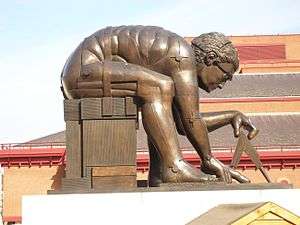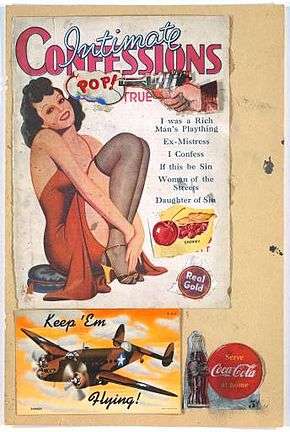Eduardo Paolozzi
| Sir Eduardo Paolozzi | |
|---|---|
 Paolozzi follows William Blake's 1795 print Newton in illustrating how Isaac Newton's equations changed our view of the world to being one determined by mathematical laws (1995). | |
| Born |
7 March 1924 Leith, Edinburgh, Scotland |
| Died | 22 April 2005 (aged 81) |
| Education | Slade School of Fine Art |
| Known for | Sculpture, art |
Sir Eduardo Luigi Paolozzi CBE RA (7 March 1924 – 22 April 2005) was a Scottish sculptor and artist. He is widely considered to be one of the pioneers of pop art.
Early years

Eduardo Paolozzi was born on 7 March 1924, in Leith in north Edinburgh, Scotland, and was the eldest son of Italian immigrants. In June 1940, when Italy declared war on Britain, Paolozzi was interned (along with most other Italian men in Britain). During his three-month internment at Saughton prison his father, grandfather and uncle, who had also been detained, were among the 446 Italians who drowned when the ship carrying them to Canada, the Arandora Star, was sunk by a German U-boat.[1]
Paolozzi studied at the Edinburgh College of Art in 1943, briefly at Saint Martin's School of Art in 1944, and then at the Slade School of Fine Art at University College London from 1944 to 1947, after which he worked in Paris. While in Paris from 1947 to 1949, Paolozzi became acquainted with Alberto Giacometti, Jean Arp, Constantin Brâncuși, Georges Braque and Fernand Léger. This period became an important influence for his later work.[2] For example, the influence of Giacometti and many of the original Surrealists he met in Paris can be felt in the group of lost-wax sculptures made by Paolozzi in the mid-1950s. Their surfaces studded with found objects and machine parts, were to gain him recognition.[3]
Career
After Paris, he moved back to London eventually establishing his studio in Chelsea. The studio was a workshop filled with hundreds of found objects, models, sculptures, materials, tools, toys and stacks of books.[4] Paolozzi was interested in everything and would use a variety of objects and materials in his work, particularly his collages.[5] In 1955 he moved with his family to the village of Thorpe-le-Soken in Essex. Together with Nigel Henderson he established Hammer Prints Limited, a design company producing wallpapers, textiles and ceramics that were initially manufactured at Landermere Wharf, and when his evening course in printed textile design at the Central School of Art and Design attracted the Trinidadian graphics student Althea McNish, he was instrumental in pointing her towards her future career as a textile designer. Paolozzi came to public attention in the 1950s by producing a range of striking screenprints and "Art Brut" sculpture. He was a founder of the Independent Group in 1952, which is regarded as the precursor to the mid-1950s British and late 1950s American Pop Art movements. His seminal 1947 collage "I was a Rich Man's Plaything" is considered the earliest standard bearer representing Pop Art.[6][7][8] He always described his work as surrealist art and, while working in a wide range of media though his career, became more closely associated with sculpture. Paolozzi is recognized for producing largely lifelike statuary works, but with rectilinear (often cubic) elements added or removed, or the human form deconstructed in a cubist manner.

He taught sculpture and ceramics at several institutions, including the Hochschule für Bildende Künste in Hamburg (1960–62), University of California, Berkeley (in 1968) and at the Royal College of Art. Paolozzi had a long association with Germany, having worked in Berlin from 1974 as part of the Berlin Artist Programme of the German Academic Exchange Programme. He was a professor at the Fachhochschule in Cologne from 1977 to 1981, and later taught sculpture at the Akademie der Bildenden Künste in Munich. Paolozzi was fond of Munich and many of his works and concept plans were developed in a studio he kept there, including the mosaics of the Tottenham Court Road Station in London.[5] He took a stab at industrial design in the 1970s with a 500-piece run of the upscale Suomi tableware by Timo Sarpaneva that Paolozzi decorated for the German Rosenthal porcelain maker's Studio Linie.[9]
Paolozzi’s graphic work of the 1960s was highly innovative. In a series of works he explored and extended the possibilities and limits of the silkscreen medium. The resulting prints are characterised by Pop culture references and technological imagery. These series are: As Is When (12 prints on the theme of Paolozzi’s interest in the philosopher Ludwig Wittgenstein; published as a limited edition of 65 by Editions Alecto, 1965); Moonstrips Empire News (100 prints, eight signed, in an acrylic box; published as a limited edition of 500 by Editions Alecto, 1967); Universal Electronic Vacuu (10 prints, poster and text; published by Paolozzi as a limited edition of 75, 1967); General Dynamic Fun. (part 2 of Moonstrips Empire News;. 50 sheets plus title sheet; boxed in five5 versions; published as a limited edition of 350 by Editions Alecto, 1970).
In the 1960s and 1970s, Paolozzi artistically processed man-machine images from popular science books by German doctor and author Fritz Kahn (1888–1968), such as in his screenprint "Wittgenstein in New York" (1965), the print series Secrets of Life – The Human Machine and How it Works (1970), or the cover design for John Barth’s novel Lost in the Funhous (Penguin, 1972). As recently as 2009, the reference to Kahn was discovered by Uta and Thilo von Debschitz during their research of work and life of Fritz Kahn.[10]
Later career
Paolozzi was appointed CBE in 1968[11] and in 1979 he was elected to the Royal Academy. During the late 1960s, he started contributing to literary magazine Ambit, which began a lifelong collaboration.
He was promoted to the office of Her Majesty's Sculptor in Ordinary for Scotland in 1986, which he held until his death. He also received an Honorary Doctorate from Heriot-Watt University in 1987.[12]
Paolozzi was knighted by Queen Elizabeth II in 1989 as Knight Bachelor (Kt).[13]
In 1994, Paolozzi gave the Scottish National Gallery of Modern Art a large body of his works, and much of the content of his studio. In 1999 the National Galleries of Scotland opened the Dean Gallery to display this collection, and the gallery displays a recreation of Paolozzi's studio, with its contents evoking the original London and Munich locations.[4]
In 2001, Paolozzi suffered a near-fatal stroke, causing an incorrect magazine report that he had died. The illness made him a wheelchair user, and he died in a hospital in London in April 2005.
In 2013, Pallant House Gallery in Chichester held a major retrospective Eduardo Paolozzi: Collaging Culture (6 July −13 October 2013), featuring more than 100 of the artists works, including sculpture, drawings, textile, film, ceramics and paper collage. Pallant House Gallery has an extensive collection of Paolozzi's work gifted and loaned by the architect Colin St John Wilson, who commissioned Paolozzi's sculpture "Newton After Blake" for the British Library.
Notable works

- The mosaic patterned walls of the Tottenham Court Road tube station. Some of these were removed as part of a redevelopment of the station, and were donated to the collection of the University of Edinburgh.[14][15]
- The cover of Paul McCartney's album Red Rose Speedway
- The ceiling panels and window tapestry at Cleish Castle
- The Piscator sculpture outside Euston Station, London
- Relief aluminium doors for the University of Glasgow's Hunterian Gallery
- The bronze sculpture Newton, after William Blake, 1995, in the piazza of the British Library
- The Manuscript of Monte Cassino, an open palm, a section of limb and a human foot, located at Leith Walk, looking towards Paolozzi's birthplace Leith
- The Head of Invention sculpture on the South Bank in front of the Design Museum
- The sculpture A Maximis Ad Minima in Kew Gardens at the west end of the Princess of Wales Conservatory.
- The mosaics in Redditch Town Centre.
- The Athena sculpture in the foyer of the John McIntosh Arts Centre at The London Oratory School.
- The Faraday sculpture at the University of Birmingham.
- The Artist as Hephaestus, displayed on High Holborn from 1987 to late 2012
Other work
_in_the_Scottish_National_Gallery_Of_Modern_Art.jpg)
- Eduardo Paolozzi played a deaf-mute in Lorenza Mazzetti's 1956 Free Cinema film Together, alongside the painter Michael Andrews.
- A photograph of Paolozzi's large, well-worn right hand was selected by Lord Snowdon as the cover image for his book Photographs by Snowdon: A Retrospective (August 2000).
Writings
- Eduardo Paolozzi by Eduardo Paolozzi, Tate, London, 1971
- Recurring themes by Eduardo Paolozzi, Rizzoli (1984), ISBN 978-0-8478-0573-0
- Metafisikal Translations by Eduardo Paolozzi, Lelpra, London, 1962
See also
Sources
- ↑ "NAS gets behind bars", The National Archives of Scotland.
- ↑ ″Paolozzi Arches Noah″, Exhibit Catalog, Münchner Stadtmuseum, 1990.
- ↑ Jonathan Clark. "Eduardo Paolozzi (1924–2005) – Jonathan Clark Fine Art".
- 1 2 "Paolozzi Studio", National Galleries of Scotland.
- 1 2 ″Mythologies″, Exhibit Catalog, The Scottish Gallery, 2–26 May 1990.
- ↑ Livingstone, M. (1990), Pop Art: A Continuing History, New York: Harry N. Abrams, Inc.
- ↑ "Eduardo Paolozzi", Exhibit Catalog, Hefte der Akademie der Bildenden Künste, 1977.
- ↑ "'I was a Rich Man's Plaything', Sir Eduardo Paolozzi – Tate". Tate.
- ↑ [Anon.] (1976). "Faenza-Goldmedaille für SUOMI". Artis. 29: 8. ISSN 0004-3842.
- ↑ Uta and Thilo von Debschitz (2009). Man Machine / Maschine Mensch. fritz-kahn.com. Springer Wien New York. ISBN 978-3-211-99181-7.
- ↑ The London Gazette: (Supplement) no. 44484. p. 11. 29 December 1967.
- ↑ [email protected]. "Heriot-Watt University Edinburgh: Honorary Graduates". www1.hw.ac.uk. Retrieved 2016-04-06.
- ↑ The London Gazette: (Supplement) no. 51578. p. 1. 30 December 1988.
- ↑ "Tube station mosaics to be seen in new light in artist's home city". Edinburgh College of Art. 28 July 2015.
- ↑ "Paolozzi mosaic restoration work starts in ECA Sculpture Court". Edinburgh College of Art. 26 October 2015.
External links
| Wikimedia Commons has media related to Eduardo Paolozzi. |
- Tate Collection of Sir Eduardo Paolozzi: 381 Works
- Works in National Galleries of Scotland
- "Sir Eduardo Paolozzi", Daily Telegraph obituary, 23 April 2005
- "Pop artist Paolozzi dies aged 81", BBC News, 22 April 2005
- Photos of some of Paolozzi's work
- The Tottenham Court Road Underground Station mosaics
- Sir Eduardo Paolozzi Gallery Web Site
- Sir Eduardo Paolozzi Projects 1972 – 2000
- Sir Eduardo Paolozzi – Jonathan Clark Fine Art
- Independent Gallery
- Paolozzi's internment recorded in Saughton Prison records, National Archives of Scotland
- John-Paul Stonard, "The ‘Bunk’ collages of Eduardo Paolozzi", The Burlington Magazine, April 2008
- Designer Nicole Farhi on her "friend and mentor" Eduardo Paolozzi, Daily Telegraph, 6 July 2013
- "The Subject is S.I.N.". Review of the Sixties screenprints